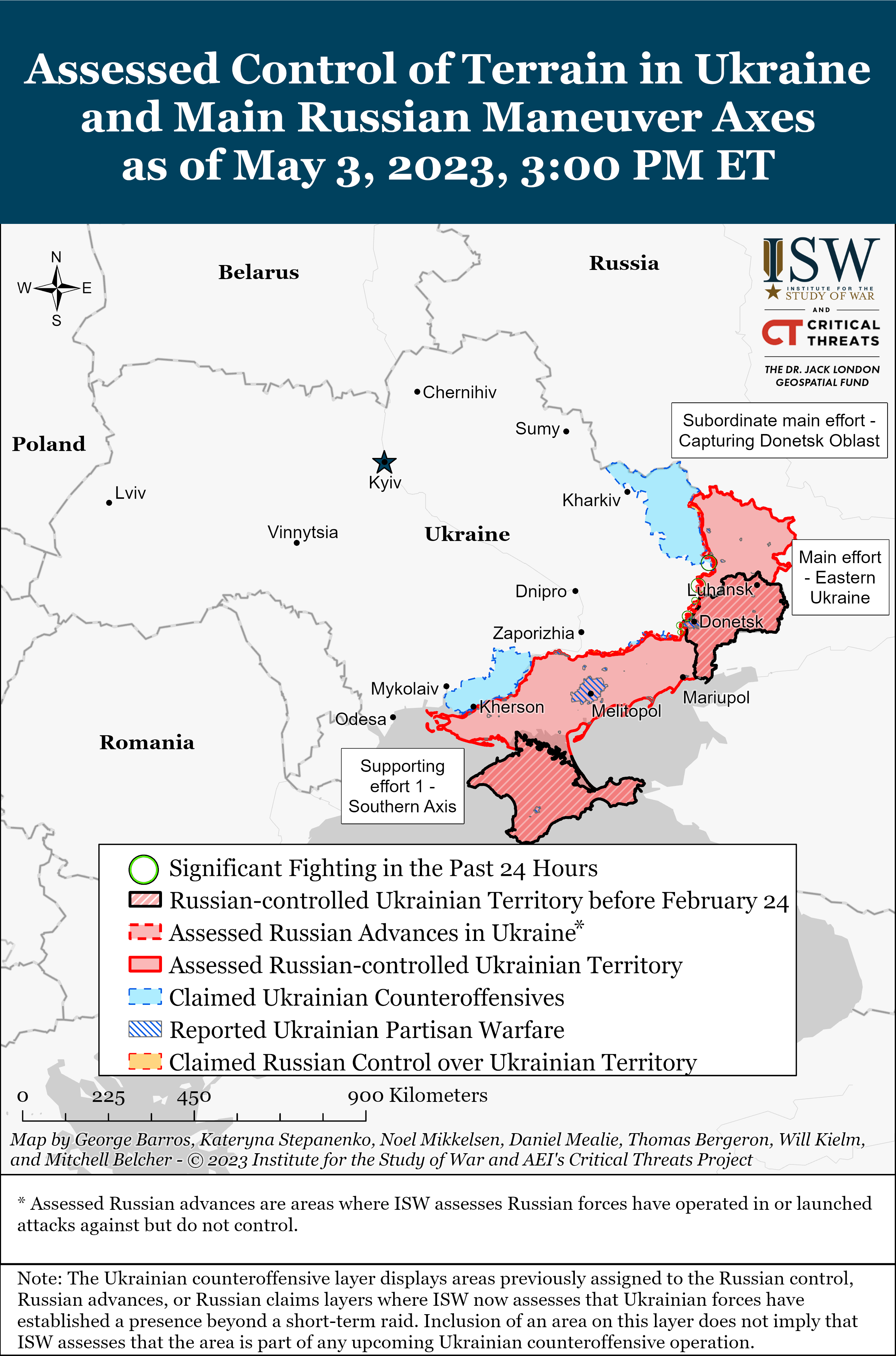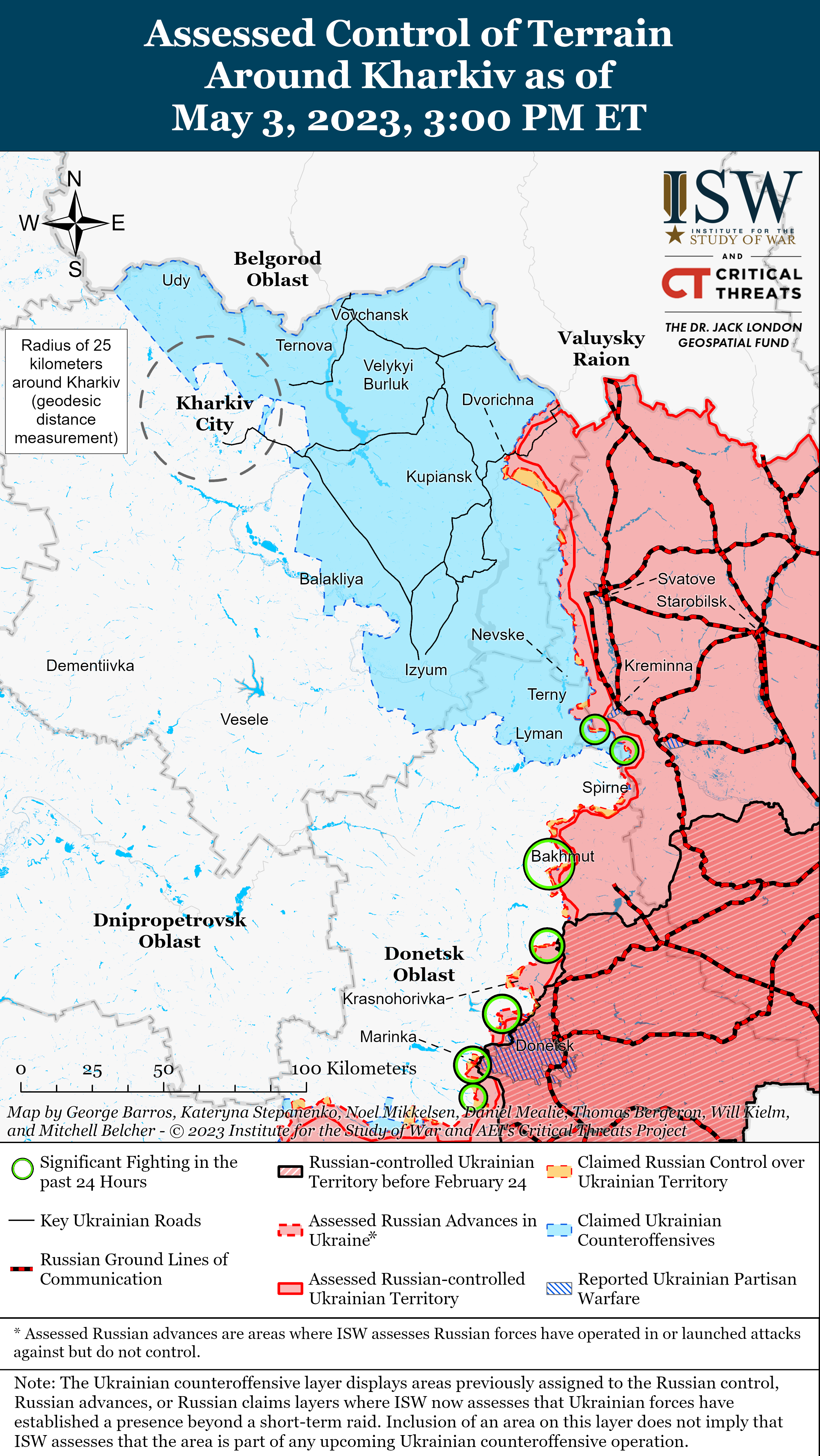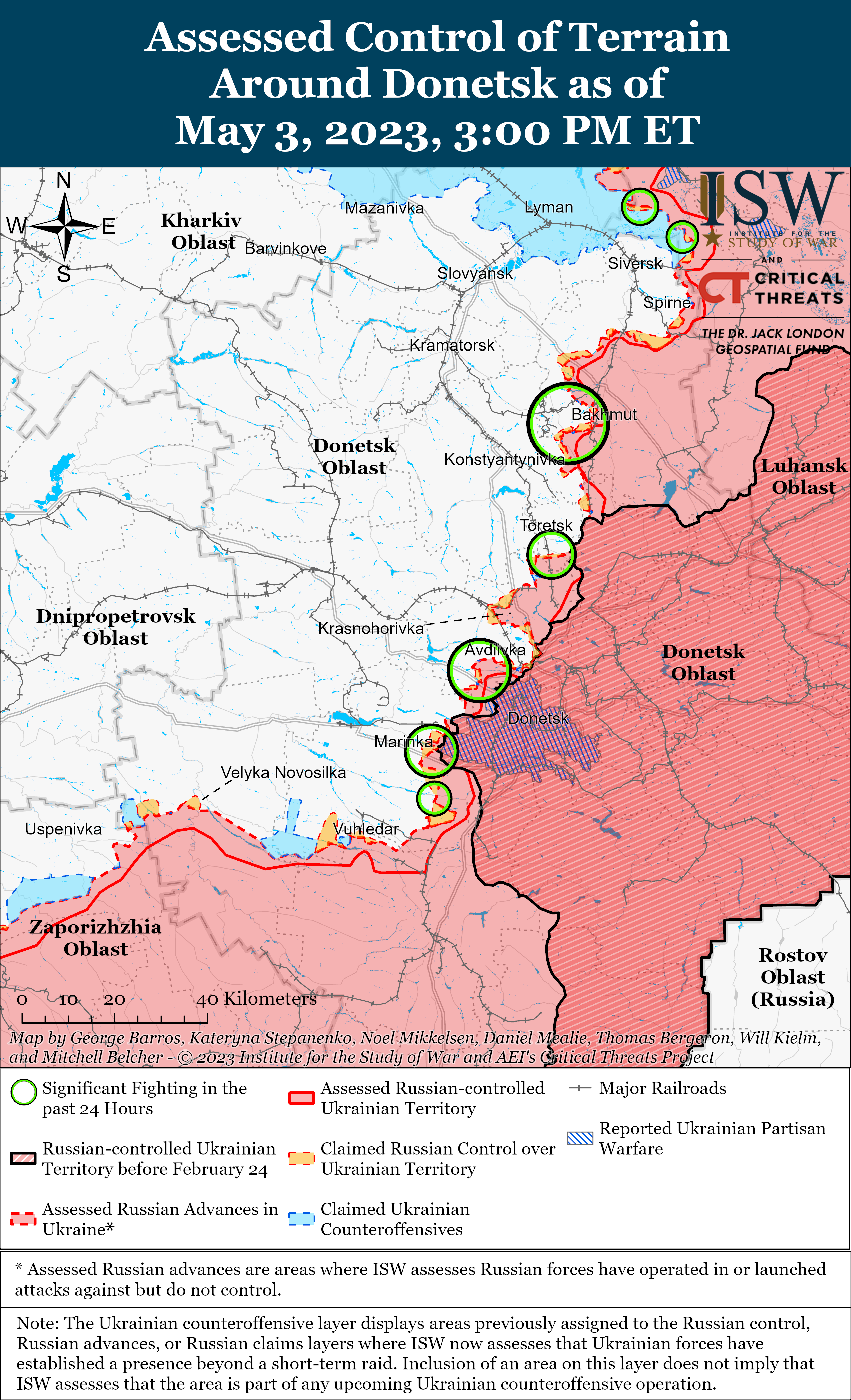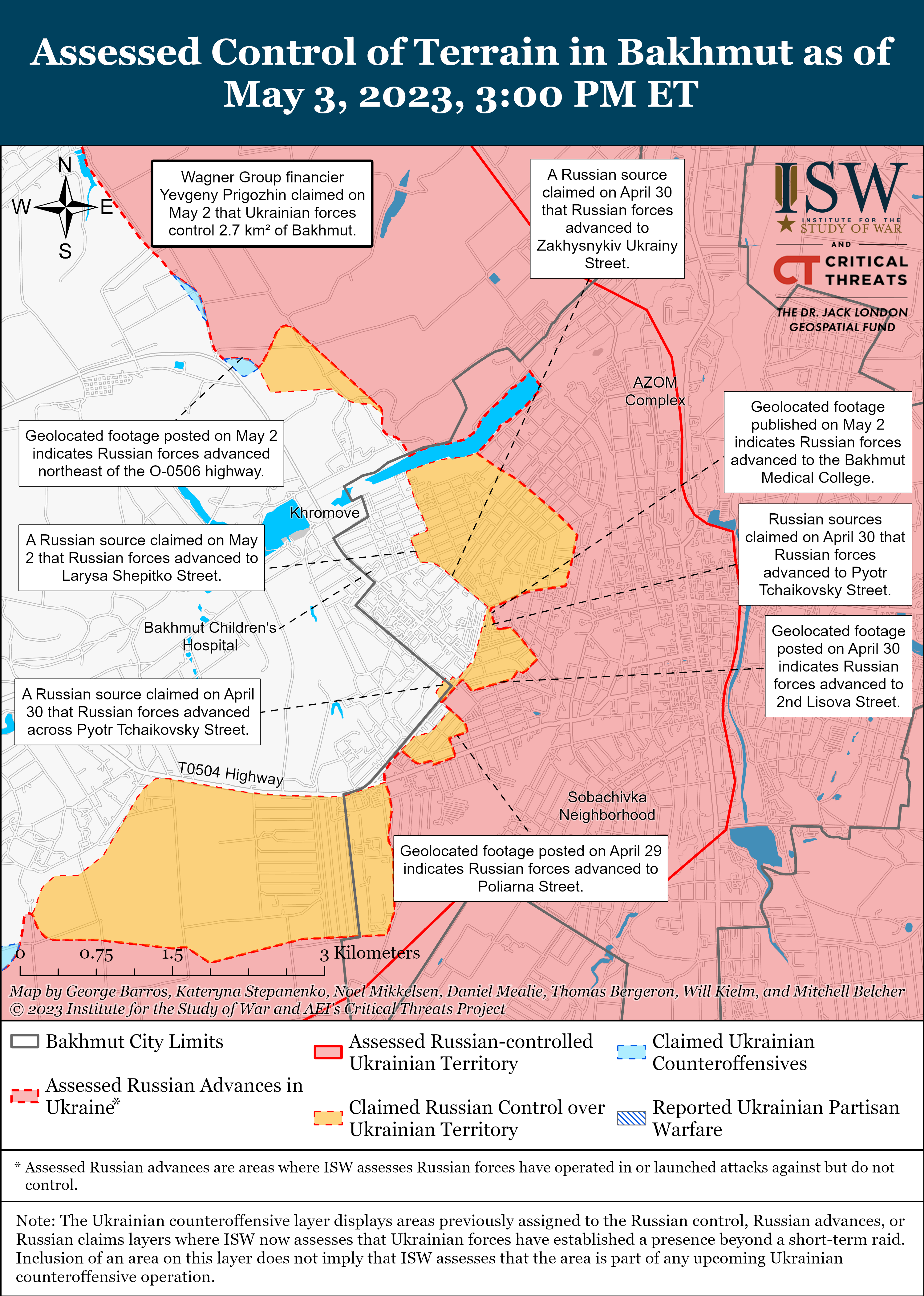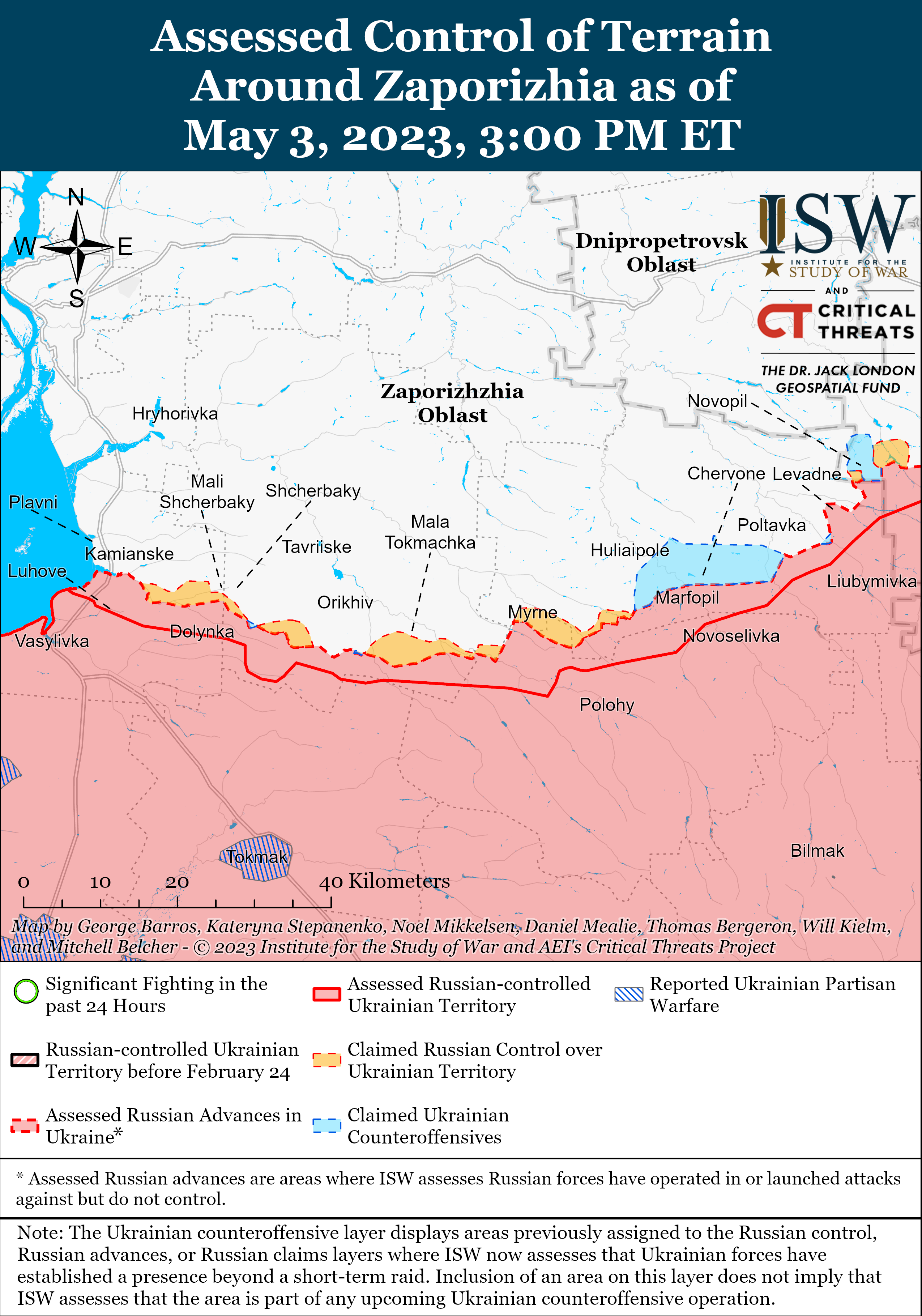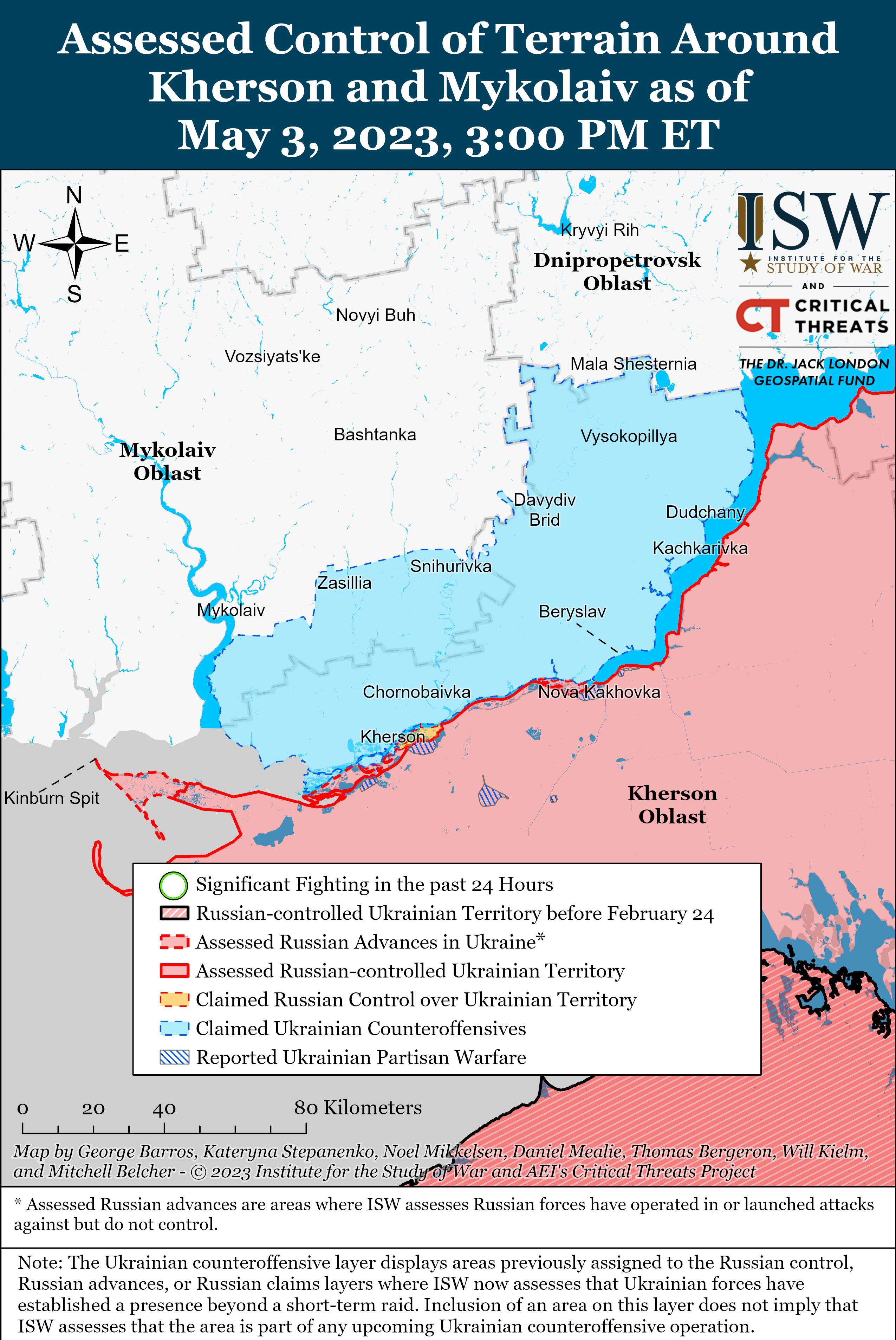Karolina Hird, Grace Mappes, Nicole Wolkov, Layne Philipson, and Frederick W. Kagan
May 3, 2023, 5:30pm ET
Click here to see ISW’s interactive map of the Russian invasion of Ukraine. This map is updated daily alongside the static maps present in this report.
Click here to access ISW’s archive of interactive time-lapse maps of the Russian invasion of Ukraine. These maps complement the static control-of-terrain map that ISW produces daily by showing a dynamic frontline. ISW will update this time-lapse map archive monthly.
Russia accused Ukraine of conducting a drone strike against the Kremlin on May 3. Social media footage circulated on May 3 shows a drone detonating near a flagpole on top of the Kremlin Senate Palace building in Moscow as two unidentified people climbed up the dome of the building.[1] The Kremlin accused Ukraine of orchestrating “a planned terrorist attack” with the intent of assassinating Russian President Vladimir Putin and clarified that Putin was not at the Kremlin at the time of the attack and was therefore unharmed.[2] Ukrainian officials, including Ukrainian President Volodymyr Zelensky, stressed that Ukraine did not conduct the attack.[3]
Russia likely staged this attack in an attempt to bring the war home to a Russian domestic audience and set conditions for a wider societal mobilization. Several indicators suggest that the strike was internally conducted and purposefully staged. Russian authorities have recently taken steps to increase Russian domestic air defense capabilities, including within Moscow itself, and it is therefore extremely unlikely that two drones could have penetrated multiple layers of air defense and detonated or been shot down just over the heart of the Kremlin in a way that provided spectacular imagery caught nicely on camera. Geolocated imagery from January 2023 shows that Russian authorities have been placing Pantsir air defense systems near Moscow to create air defense circles around the city.[4] A strike that avoided detection and destruction by such air defense assets and succeeded in hitting as high-profile of a target as the Kremlin Senate Palace would be a significant embarrassment for Russia. The Kremlin’s immediate, coherent, and coordinated response to the incident suggests that the attack was internally prepared in such a way that its intended political effects outweigh its embarrassment. The Kremlin immediately accused Ukraine of conducting a terror attack, and Russian official responses coalesced rapidly around this accusation.[5] If the drone attack had not been internally staged it would have been a surprise event. It is very likely that the official Russian response would initially have been much more disorganized as Russian officials scrambled to generate a coherent narrative and offset the rhetorical implications of a clear informational embarrassment. The Kremlin has notably failed to generate a timely and coherent informational response to other military humiliations not of its own making, including the falls of Balakliya and Kherson City in September and November 2022.[6]
The rapid and coherent presentation of an official Russian narrative around the strike suggests that Russia staged this incident in close proximity to the May 9th Victory Day holiday in order to frame the war as existential to its domestic audience. The Kremlin may use the strike to justify either canceling or further limiting May 9th celebrations, actions that would likely augment the information effort framing the war in Ukraine as directly threatening Russian observance of revered historical events. ISW has previously assessed that Russia is employing an array of measures to frame the war in Ukraine as existential to Russia’s domestic audience and to prepare for wider societal mobilization.[7]
Some Russian nationalist milbloggers seized on the Kremlin drone strike to call for Russian escalation in the war despite the fact that Russia currently lacks the military capability to do so. Many pro-war milbloggers, including ardent nationalist and former Russian officer Igor Girkin, criticized the Kremlin for allowing Ukraine to cross multiple Russian “red lines” with no adequate retaliation and called for Russia to escalate in response, including by targeting Ukrainian President Volodymyr Zelensky and other Ukrainian decision-makers.[8] This sect of milbloggers emphasized their own embarrassment at the Kremlin strike, comparing it to the humiliation of a single German civilian pilot landing a small aircraft near the Kremlin in 1987.[9] Other Russian milbloggers, including those with close Kremlin affiliations, criticized the high degree of outcry in the Russian information space.[10] These milbloggers largely advocated against retaliatory military escalation on the grounds that this strike does not change the operational or strategic situation in the war, instead calling for a cautious response while acknowledging the sting of embarrassment over the strike.[11] This messaging from pro-Kremlin milbloggers could support the assessment that the purpose of this false-flag attack was to justify increased mobilization measures rather than any sort of escalation.
The Kremlin may be planning to conduct other false flag operations and increase disinformation ahead of a Ukrainian counteroffensive in order to increase domestic support for the war. The Ukrainian Resistance Center reported on May 2 that Russian forces in Bryansk and Kursk oblasts received Ukrainian uniforms in order to conduct a false flag operation in border areas.[12] The Ukrainian Resistance Center reported on May 3 that Russian forces may simulate a hostage taking and noted that “Storm” detachments of the Russian 13th Guards Tank Regiment (4th Guards Tank Division) and 1st Motorized Rifle Regiment (2nd Guards Motorized Rifle Division) of the 1st Guards Tank Army of the Western Military District arrived in Ivanivske in Kursk Oblast and Yamnoye in Bryansk Oblast.[13] The 13th Guards Tank Regiment suffered massive losses early in the war in Chernihiv Oblast and in fall of 2022 during the Ukrainian counteroffensive in Kharkiv Oblast.[14] This report that elements of the 13th Guards Tank Regiment are in Bryansk or Kursk Oblast suggests that the regiment is not in Ukraine and is unready to return to battle. Russian milbloggers amplified a claim from state-run media outlet RT that Ukrainian forces are preparing a provocation against Transnistria and will attempt to enter Transnistria between May 9 and 15.[15] The Kremlin has previously attempted to portray Ukraine as an existential threat to Russia’s territorial integrity and to warn of supposed Ukrainian provocations to be conducted in Moldova.[16]
Wagner Group financier Yevgeny Prigozhin baselessly claimed on May 3 that the Ukrainian counteroffensive has already begun, likely in order to exploit information space anxieties and call for increased Russian military support for Wagner’s Bakhmut offensive. In an audio recording posted on May 3, Prigozhin says that he believes that Ukraine has already begun its counteroffensive and cited an increase in Ukrainian activity “along the perimeter” of the Bakhmut front.[17] Prigozhin also claimed that Wagner’s flanks, currently held by conventional Russian airborne (VDV) troops, are “not in the best way” and stated that he will not speculate on how reliable they are to maintain “politeness.”[18] Prigozhin’s comment on the state of the flanks is likely a thinly-veiled criticism of the Russian Ministry of Defense (MoD) and its ability to help Wagner hold Bakhmut and suggests that Prigozhin is blaming the MoD for being unable to hold off Ukrainian localized counterattacks in Bakhmut. Prigozhin concluded that he anticipates a more “active phase” of counteroffensive actions to begin in the next few days.[19] Prigozhin is likely using this claim to benefit from continued concerns in the Russian information space regarding a Ukrainian counteroffensive and to lobby for increased support for Wagner amid continued pleas for the Russian MoD to provide Wagner more ammunition for its offensive on Bakhmut.[20] ISW has observed no additional evidence to support Prigozhin’s claims and does not assess that a Ukrainian counter-offensive has begun around Bakhmut.
Russian forces conducted a Shahed-131/136 drone strike against Ukraine on the night of May 2 to 3. The Ukrainian General Staff reported on May 3 that Russian forces attacked Ukrainian territory from Bryansk Oblast and the southeast coast of the Sea of Azov with 26 Iranian-made Shahed-131/136 drones and that Ukrainian air defenses shot down 21 of the 26 drones.[21] The Kyiv Oblast Military Administration stated that Russian forces attacked Kyiv Oblast for the third time in six consecutive days.[22] Ukraine’s Southern Operational Command reported that Shahed drones also targeted Kirovohrad and Mykolaiv oblasts.[23]
Key Takeaways
- Russia accused Ukraine of conducting a drone strike against the Kremlin.
- Russia likely staged this attack in an attempt to bring the war home to a Russian domestic audience and set conditions for a wider societal mobilization.
- The rapid and coherent presentation of an official Russian narrative around the strike suggests that Russia staged this attack in close proximity to the May 9th Victory Day holiday in order to frame the war as existential to its domestic audience.
- Some Russian nationalist milbloggers seized on the Kremlin drone strike to call for Russian escalation in the war despite the fact that Russia currently lacks the military capability to do so.
- The Kremlin may be planning to conduct other false flag operations and to increase disinformation ahead of a Ukrainian counteroffensive in order to increase domestic support for the war.
- Wagner Group financier Yevgeny Prigozhin baselessly claimed on May 3 that the Ukrainian counteroffensive has already begun, likely in order to exploit information space anxieties and call for increased Russian military support for Wagner’s Bakhmut offensive.
- Russian forces conducted a Shahed-131/136 drone strike on the night of May 2 to 3.
- Russian forces continued limited ground attacks near Kreminna.
- Russian forces continued to make gains in and around Bakhmut and continued to conduct ground attacks on the Avdiivka-Donetsk City line.
- Russian forces conducted heavy air and artillery strikes against west (right) bank Kherson Oblast.
- Russian officials continue to incentivize military service by providing social benefits to families of participants in the war.
- The Russian Federal Security Service (FSB) claimed that it prevented a “terrorist” attack against three Crimean officials.
We do not report in detail on Russian war crimes because these activities are well-covered in Western media and do not directly affect the military operations we are assessing and forecasting. We will continue to evaluate and report on the effects of these criminal activities on the Ukrainian military and the Ukrainian population and specifically on combat in Ukrainian urban areas. We utterly condemn these Russian violations of the laws of armed conflict, Geneva Conventions, and humanity even though we do not describe them in these reports.
- Russian Main Effort – Eastern Ukraine (comprised of two subordinate main efforts)
- Russian Subordinate Main Effort #1 – Capture the remainder of Luhansk Oblast and push westward into eastern Kharkiv Oblast and encircle northern Donetsk Oblast
- Russian Subordinate Main Effort #2 – Capture the entirety of Donetsk Oblast
- Russian Supporting Effort – Southern Axis
- Russian Mobilization and Force Generation Efforts
- Activities in Russian-occupied areas
Russian Main Effort – Eastern Ukraine
Russian Subordinate Main Effort #1 – Luhansk Oblast (Russian objective: Capture the remainder of Luhansk Oblast and push westward into eastern Kharkiv Oblast and northern Donetsk Oblast)
Russian forces continued limited ground attacks near Kreminna on May 3. The Ukrainian General Staff reported that Russian forces conducted unsuccessful offensive operations near Dibrova (5km southwest of Kreminna) and Bilohorivka (10km south of Kreminna).[24] A Russian milblogger claimed that Russian troops continued efforts to advance towards Novoselivske (15km northwest of Svatove), Dibrova, the Serebrianska forest area (10km south of Kreminna), and Bilohorivka.[25] Ukrainian Eastern Group of Forces Spokesperson Serhiy Cherevaty stated that Russian forces have not advanced in “some time” on the Kupyansk-Svatove-Lyman line and are behaving cautiously but maintaining high rates of artillery fire.[26] Cherevaty noted that Russian forces fired over 565 artillery rounds at Ukrainian positions and engaged in 11 combat clashes on this line over the past day.[27]
Russian Subordinate Main Effort #2 – Donetsk Oblast (Russian Objective: Capture the entirety of Donetsk Oblast, the claimed territory of Russia’s proxies in Donbas)
Russian forces continued to make gains in and around Bakhmut as of May 3. Geolocated footage from May 2 and 3 shows that Russian forces advanced closer to the O0506 highway northwest of Khromove (immediately west of Bakhmut) and captured the Bakhmut Medical College in western Bakhmut.[28] A Russian milblogger claimed that Russian and Ukrainian forces continued fighting north of Bakhmut near Bohdanivka (6km northwest of Bakhmut) and that Wagner Group forces advanced in western and southern Bakhmut.[29] Another milblogger claimed on May 2 that Russian and Ukrainian forces continued fighting north of the O0506 highway.[30] The Ukrainian General Staff reported that Russian forces continued attacking in Bakhmut and conducted unsuccessful ground attacks towards Ivanivske (6km west of Bakhmut), Predtechyne 14km southwest of Bakhmut), and Niu York (30km southwest of Bakhmut).[31] Wagner Group financier Yevgeny Prigozhin claimed on May 2 that Ukrainian forces control 2.7 square kilometers of Bakhmut, which is largely consistent with ISW’s current assessed Ukrainian control of 1.89 square kilometers in Bakhmut.[32]
The Russian Ministry of Defense (MoD) acknowledged limited Ukrainian counterattacks in the Avdiivka area. The Russian MoD claimed on May 3 that Russian forces repelled a Ukrainian ground attack on May 2 in an unspecified area of the Oleksandro-Kalynove direction, referring to the area between Avdiivka and Toretsk.[33] ISW has not observed visual evidence of successful Ukrainian counterattacks in the Avdiivka area, and these attacks are likely part of an ongoing pattern of limited and localized attacks, as ISW has recently assessed.[34]
Russian forces continued to conduct ground attacks on the Avdiivka-Donetsk City line on May 3. The Ukrainian General Staff reported that Russian forces conducted unsuccessful ground attacks near Sieverne (7km west of Avdiivka), Pervomaiske (11km southwest of Avdiivka), Marinka (27km southwest of Avdiivka), and Novomykhailivka (10km southwest of Donetsk City).[35] Russian milbloggers claimed that Russian forces are regrouping west of Novobakhmutivka (9km northwest of Avdiivka) and that Ukrainian targeting of Russian firing positions has slowed down the pace of Russian artillery fire.[36] Another Russian milblogger claimed that Russian forces broke through Ukrainian defensive lines and established a foothold on the southern outskirts of the Horhaz enterprise in southwestern Marinka.[37] A Russian milblogger indicated that elements of the “Patriot” private military company (PMC), which is reportedly affiliated with the Russian MoD, is operating along the Avdiivka-Donetsk City axis.[38]
A Ukrainian official stated that Russian forces are increasing preparations for hostilities in rear areas of western Donetsk Oblast. Ukrainian Main Military Intelligence Directorate (GUR) Spokesperson Vadym Skibitskyi stated that Russian forces are restoring infrastructure, including port infrastructure, necessary to conduct hostilities and circular defense in the Mariupol area.[39] Russian forces did not conduct any confirmed or claimed ground attacks in western Donetsk Oblast on May 3.[40]
Russian Supporting Effort – Southern Axis (Russian objective: Maintain frontline positions and secure rear areas against Ukrainian strikes)
Russian forces conducted heavy air and artillery strikes against west (right) bank Kherson Oblast on May 3. Ukraine’s Southern Operational Command reported that Russian troops carried out 110 artillery strikes against areas on the west bank with over 550 shells and struck civilian infrastructure in Kherson City.[41] Geolocated imagery posted on May 3 shows the aftermath of Russian shelling of the “Epicenter” hypermarket in Kherson City.[42] The Southern Operational Command also reported that Russian tactical aviation launched five guided aerial bombs at Kizomys, just west of Kherson City.[43] Russian forces continued to shell along the line of contact in Zaporizhia Oblast.[44]
Ukrainian forces continued striking Russian concentration areas on the east (left) bank of Kherson Oblast on May 3. Ukraine’s Southern Operational Command reported that Ukrainian troops conducted 100 fire missions against Russian weapons, equipment, and personnel concentrations on the east bank.[45] A local Kherson Oblast Telegram channel posted an image of a pamphlet on the east bank (potentially distributed by Ukrainian partisans) that warns residents to avoid being near positions of the 205th Separate Motorized Rifle Brigade (49th Combined Arms Army, Southern Military District) in the Nova Kakhovka area due to potential Ukrainian strikes on these positions.[46] A Russian milblogger claimed that Ukrainian troops shelled a number of settlements along the east bank on the night of May 2 to 3.[47]
Russian sources continue to disproportionately amplify claims of routine Ukrainian activity along the Zaporizhia Oblast frontline in order to suggest that the counteroffensive may have already begun. Zaporizhia Oblast occupation deputy Vladimir Rogov claimed on May 3 that a mechanized Ukrainian group “went on the offensive” south of Orikhiv and reported that Russian forces stopped the advance and forced Ukrainian troops to withdraw.[48] Rogov has made frequent claims over the past few months that Ukrainian forces are preparing to launch a counteroffensive in Zaporizhia Oblast and has frequently used such claims to further information operations, as ISW has previously assessed.[49] Russian milbloggers and other sources routinely report on Ukrainian activity near Orikhiv.
Russian Mobilization and Force Generation Efforts (Russian objective: Expand combat power without conducting general mobilization)
Russian officials continue to incentivize military service by providing social benefits to families of participants in the war. United Russia Secretary Andrey Turchak claimed on May 3 that the “special military operation” working group submitted a bill to the Russian State Duma that would provide the children of volunteers and all soldiers who died in the war in Ukraine with priority enrollment in kindergartens, schools, and summer camps.[50] Turchak claimed that this bill is part of the wider Russian effort to expand social benefits to all participants of the war and their families.[51]
Activities in Russian-occupied areas (Russian objective: Consolidate administrative control of annexed areas; forcibly integrate Ukrainian civilians into Russian sociocultural, economic, military, and governance systems)
The Russian Federal Security Service (FSB) claimed that it prevented a “terrorist” attack against three Crimean officials on May 3. The FSB claimed that it had arrested seven people connected with the Ukrainian Security Service (SBU) on May 3 under allegations that they were planning to assassinate occupation head of Crimea Sergey Aksenov and other Russian occupation officials based in Crimea.[52]
Russian occupation officials are likely purposefully engaging in corrupt and provocative activities in occupied areas of Ukraine in order to generate instability and target pro-Ukrainian sentiment. Deputy Ukrainian Defense Minister Hanna Malyar stated on May 3 that Russian forces are importing groups of trained provocateurs to occupied territories in an effort to increase the number of conflicts between pro-Russians and Ukrainians in public places.[53] Malyar stated that Russian investigative bodies solve cases involving public fights in favor of pro-Russian provocateurs, pardoning them of criminal liability in an effort to sow fear of anti-Russia expression in occupied territories.[54] Malyar stated that Russia had previously used “thieves in law” to destabilize Ukraine in 2014 and 2015, which created unstable internal environments and further promoted criminal activity.[55] Former Donetsk People’s Republic official Pavel Gubarev recalled first-hand accounts on May 3 of cases in which Russian occupation authorities fabricated criminal cases, imprisoned and tortured innocent people, and engaged in corrupt financial dealings in Kherson Oblast, and suggested that releasing this information may undermine Russian moral justifications for occupying Ukrainian territory.[56]
Russian occupation authorities continue to announce medical examinations of Ukrainian children, likely in connection with the ongoing deportation of Ukrainian children to Russia under the guise of rehabilitation. Occupied Kherson Oblast Ministry of Health stated on May 3 that doctors from Crimea and Russia will conduct medical examinations on 4,336 more children in occupied Kherson Oblast by the end of the 2023 school year.[57]
Significant activity in Belarus (ISW assesses that a Russian or Belarusian attack into northern Ukraine in early 2023 is extraordinarily unlikely and has thus restructured this section of the update. It will no longer include counter-indicators for such an offensive.)
ISW will continue to report daily observed Russian and Belarusian military activity in Belarus, but these are not indicators that Russian and Belarusian forces are preparing for an imminent attack on Ukraine from Belarus. ISW will revise this text and its assessment if it observes any unambiguous indicators that Russia or Belarus is preparing to attack northern Ukraine.
The Belarusian Ministry of Defense (MoD) announced that Belarusian forces will begin the next stage of an ongoing comprehensive combat readiness check on an unspecified date in May. The Belarusian MoD claimed that Belarusian forces stationed in Grodno, Brest Oblast and in Minsk Oblast will participate in this new phase of the readiness check.[58] The Belarusian MoD also claimed that it will not call up more than 1,000 reservists as part of the readiness check.[59] The Belarusian MoD also claimed that the readiness check includes the formation of people’s militias and the performance of combat tasks to maintain martial law.[60]
The Belarusian MoD claimed that Russian Aerospace Forces and Belarusian Air and Air Defense Forces will conduct joint patrols of Belarusian airspace.[61]
Note: ISW does not receive any classified material from any source, uses only publicly available information, and draws extensively on Russian, Ukrainian, and Western reporting and social media as well as commercially available satellite imagery and other geospatial data as the basis for these reports. References to all sources used are provided in the endnotes of each update.
[1] https://twitter.com/GirkinGirkin/status/1653727329691004928; https://twitter.com/GirkinGirkin/status/1653738331270676482; https://t.me/rian_ru/201579; https://t.me/readovkanews/58065; https://t.me/readovkanews/58066; https://t.me/readovkanews/58070; https://twitter.com/666_mancer/status/1653734693257314304; https://twitter.com/Faytuks/status/1653728913711943680 ; https://twitter.com/michaelh992/status/1653734342626091011 ; https://twitter.com/IntelCrab/status/1653743589040566275 ; https://t.me/svobodnieslova/1902; https://t.me/istories_media/2459; https://t.me/bazabazon/17350; https://t.me/astrapress/26037
[2] https://t.me/rian_ru/201566; https://t.me/rian_ru/201567; https://t.me/rian_ru/201576; https://t.me/rian_ru/201575; https://t.me/rian_ru/201571; https://www.kommersant dot ru/doc/5967398?from=top_main_1; https://t.me/rian_ru/201569; https://t.me/rian_ru/201568; https://t.me/readovkanews/58064
[3] https://t.me/RBC_ua_news/49332; https://hromadske dot ua/ru/posts/u-zelenskogo-prokommentirovali-zayavlenie-rf-ob-udare-po-kremlyu-nagnetanie-situacii-pered-9-maya; https://twitter.com/Podolyak_M/status/1653746627037863937
[6] https://isw.pub/RusCampaignSept10; https://isw.pub/RusCampaignSept9; https://isw.pub/RusCampaignSept8
[7] https://isw.pub/UkrWar012023; https://isw.pub/UkrWar03042023; https://understandingwar.org/sites/default/files/Russian%20Offensive…
[8] https://t.me/boris_rozhin/84558; https://t.me/NeoficialniyBeZsonoV/24958; https://t.me/dazbastadraw/3223; https://t.me/readovkanews/58069; https://t.me/vysokygovorit/11464; https://t.me/vysokygovorit/11459; https://t.me/KRPRus/19; https://t.me/KRPRus/18; https://t.me/KRPRus/17; https://t.me/ordinaryczarizm/1799; https://t.me/KRPRus/16; https://t.me/strelkovii/4741; https://t.me/voenkorKotenok/47258; https://t.me/milinfolive/100109; https://t.me/Sladkov_plus/7611; https://t.me/Sladkov_plus/7609; https://t.me/Sladkov_plus/7608
[9] https://t.me/Sladkov_plus/7611; https://t.me/Sladkov_plus/7609; https://t.me/Sladkov_plus/7608; https://t.me/boris_rozhin/84558; https://t.me/NeoficialniyBeZsonoV/24958; https://t.me/dazbastadraw/3223; https://t.me/readovkanews/58069; https://t.me/vysokygovorit/11464; https://t.me/vysokygovorit/11459; https://t.me/KRPRus/19; https://t.me/KRPRus/18; https://t.me/KRPRus/17; https://t.me/ordinaryczarizm/1799; https://t.me/KRPRus/16; https://t.me/strelkovii/4741; https://t.me/voenkorKotenok/47258; https://t.me/milinfolive/100109;
[10] https://t.me/rybar/46572; https://t.me/rybar/46576; https://t.me/sashakots/39601; https://t.me/rybar/46578; https://t.me/vysokygovorit/11460; https://t.me/rybar/46580; https://t.me/MedvedevVesti/13940; https://t.me/boris_rozhin/84558; https://t.me/sashakots/39609; https://t.me/sashakots/39597; https://t.me/epoddubny/15810; https://t.me/m0sc0wcalling/23748
[11] https://t.me/rybar/46572; https://t.me/rybar/46576; https://t.me/sashakots/39601; https://t.me/rybar/46578; https://t.me/vysokygovorit/11460; https://t.me/rybar/46580; https://t.me/MedvedevVesti/13940; https://t.me/boris_rozhin/84558; https://t.me/sashakots/39609; https://t.me/sashakots/39597; https://t.me/epoddubny/15810; https://t.me/m0sc0wcalling/23748
[12] https://sprotyv.mod.gov. dot ua/rosiyany-gotuyut-provokatsiyi-na-pivnichnomu-kordoni-z-ukrayinoyu/
[13] https://sprotyv.mod dot gov.ua/do-organizatsiyi-provokatsiyi-na-kordoni-ukrayiny-ta-rf-zalucheni-ponad-300-soldat-armiyi-voroga/
[15] https://t.me/NeoficialniyBeZsonoV/24943; https://t.me/boris_rozhin/84551; https://t.me/wargonzo/12295
[16] https://understandingwar.org/backgrounder/russian-offensive-campaign-assessment-february-23-2023; https://understandingwar.org/backgrounder/russian-offensive-campaign-assessment-february-24-2023; https://understandingwar.org/backgrounder/russian-offensive-campaign-assessment-april-26; https://understandingwar.org/backgrounder/russian-offensive-campaign-assessment-april-8-2023
[21] https://www.facebook.com/GeneralStaff.ua/posts/pfbid02yM9WCQsK5sDmFjR4GCs2yPfwr2xTWTY2c6EzfHGouEnTeJyvBWBrbomHcQbPhkLKl; https://www.facebook.com/GeneralStaff.ua/posts/pfbid032yp8C87U4vCs5aw3HH7pTkqPvKHBUZzCTm6ZRx8faFUqyevBhWgQc4vYr6HSjbNFl
[23] https://www.facebook.com/OperationalCommandSouth/posts/pfbid02HSmQNEtKEbANV8XJtKWqHjD5ahRtuSG3w5MSZB7R8hKqdBFUBpviUkkJNHTWe55al
[24] https://www.facebook.com/GeneralStaff.ua/posts/pfbid0LDXPKnkjE7Q9Wk7JEoPn1H7N7SVGTQ7qFnzQEevwMhdaDye6QBMSmy126HhRyNvnl; https://www.facebook.com/GeneralStaff.ua/posts/pfbid02yM9WCQsK5sDmFjR4GCs2yPfwr2xTWTY2c6EzfHGouEnTeJyvBWBrbomHcQbPhkLKl
[26] https://armyinform.com dot ua/2023/05/03/mynuloyi-doby-okupanty-zavdaly-565-udariv-zi-stvolnoyi-artyleriyi-ta-rszv-na-lymansko-kupyanskomu-napryamku/
[27] https://armyinform.com dot ua/2023/05/03/mynuloyi-doby-okupanty-zavdaly-565-udariv-zi-stvolnoyi-artyleriyi-ta-rszv-na-lymansko-kupyanskomu-napryamku/; https://t.me/readovkanews/58055
[28] https://twitter.com/PaulJawin/status/1653471918777876485?s=20; https://twitter.com/auditor_ya/status/1653505461063241743?s=20; https://twitter.com/EerikMatero/status/1653457621825798151?s=20; https://twitter.com/EerikMatero/status/1653458018124611590?s=20; https://t.me/msgazdiev/1204
[30] https://twitter.com/EerikMatero/status/1653457621825798151?s=20; https://twitter.com/EerikMatero/status/1653458018124611590?s=20; https://t.me/msgazdiev/1204
[35] https://www.facebook.com/GeneralStaff.ua/posts/pfbid0LDXPKnkjE7Q9Wk7JEoPn1H7N7SVGTQ7qFnzQEevwMhdaDye6QBMSmy126HhRyNvnl; https://www.facebook.com/GeneralStaff.ua/posts/pfbid02yM9WCQsK5sDmFjR4GC…
[38] https://t.me/obtf_kaskad/2437; https://www.pravda dot com.ua/eng/news/2022/12/28/7382706/; https://www.svoboda dot org/a/29346941.html
[39] https://gur.gov dot ua/content/v-okupovanomu-krymu-rosiiany-boiatsia-vsoho-i-droniv-i-partyzaniv-i-raket-vadym-skibitskyi.html
[40] https://www.facebook.com/GeneralStaff.ua/posts/pfbid0LDXPKnkjE7Q9Wk7JEoPn1H7N7SVGTQ7qFnzQEevwMhdaDye6QBMSmy126HhRyNvn; https://www.facebook.com/GeneralStaff.ua/posts/pfbid02yM9WCQsK5sDmFjR4GC…
[41] https://www.facebook.com/OperationalCommandSouth/posts/pfbid02HSmQNEtKEbANV8XJtKWqHjD5ahRtuSG3w5MSZB7R8hKqdBFUBpviUkkJNHTWe55al
[42] **GRAPHIC** https://twitter.com/GeoConfirmed/status/1653689284606545922?s=20; https://twitter.com/Flash_news_ua/status/1653682034248744964?s=20 ; https://t.me/hueviyherson/38826 ; https://t.me/hueviyherson/38827 ; https://t.me/istories_media/2462; https://twitter.com/bayraktar_1love/status/1653787801853255680?s=20; https://twitter.com/bayraktar_1love/status/1653793018892124162?s=20 https://t.me/astrapress/26023; https://t.me/olexandrprokudin/414 ; https://www.facebook.com/100003342535443/posts/pfbid032oz5B7prMT7xAuNxt9cdhfXEwQLkYZx7bkWKS1qMBfwtCTf7BT7vqqQUkxgnHhYdl/?mibextid=DcJ9fc
[43] https://www.facebook.com/OperationalCommandSouth/posts/pfbid02HSmQNEtKEbANV8XJtKWqHjD5ahRtuSG3w5MSZB7R8hKqdBFUBpviUkkJNHTWe55al
[45] https://www.facebook.com/OperationalCommandSouth/posts/pfbid02HSmQNEtKEbANV8XJtKWqHjD5ahRtuSG3w5MSZB7R8hKqdBFUBpviUkkJNHTWe55al
[50] https://t.me/turchak_andrey/1253; https://t.me/boris_rozhin/84562; https://t.me/mobilizationnews/11671
[51] https://t.me/turchak_andrey/1245; https://understandingwar.org/backgrounder/russian-offensive-campaign-assessment-april-24-2023
[52] https://t.me/readovkanews/58041; https://t.me/readovkanews/58044; https://t.me/Aksenov82/2432; https://t.me/rybar/46564; https://t.me/boris_rozhin/84541; https://t.me/rybar/46563; https://t.me/readovkanews/58038; https://t.me/readovkanews/58042; https://t.me/boris_rozhin/84534; https://t.me/boris_rozhin/84523; https://t.me/rlz_the_kraken/58144; http://www.fsb dot ru/fsb/press/message/single.htm!id=[email protected]
